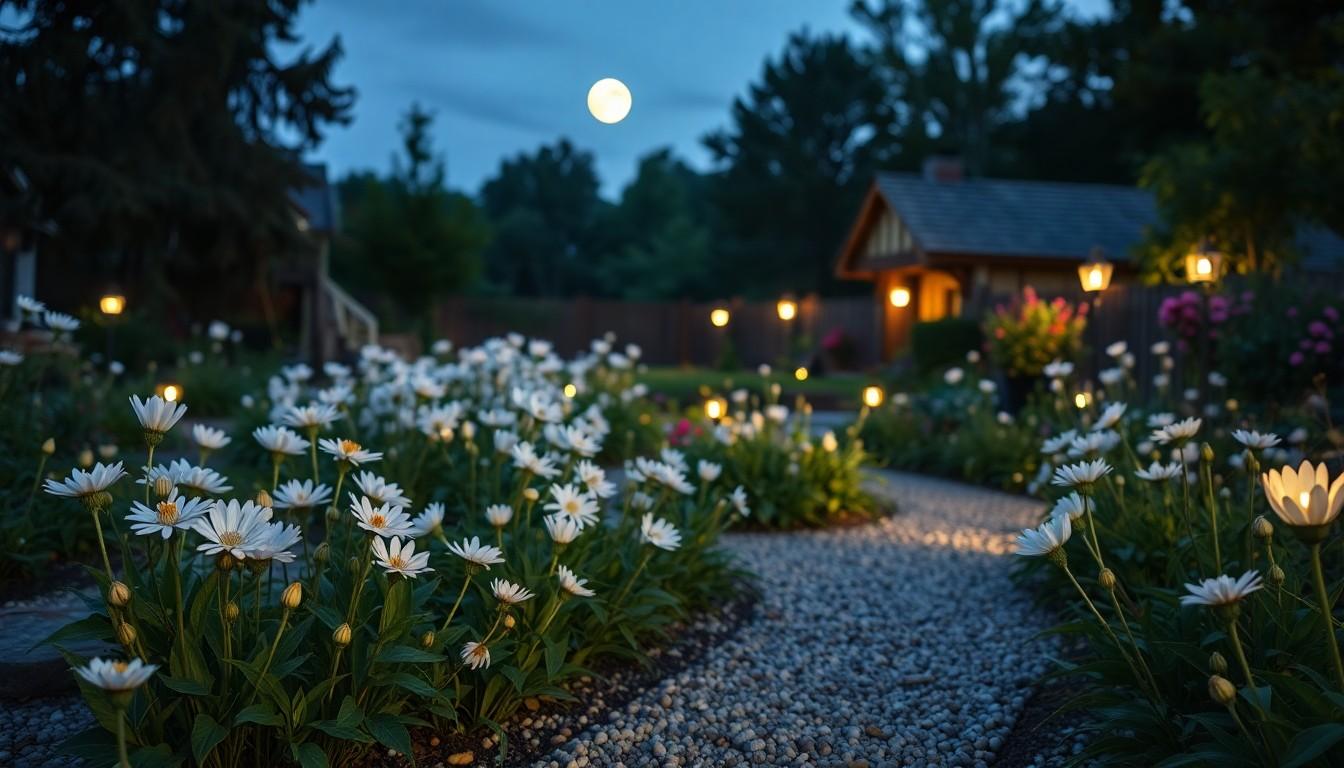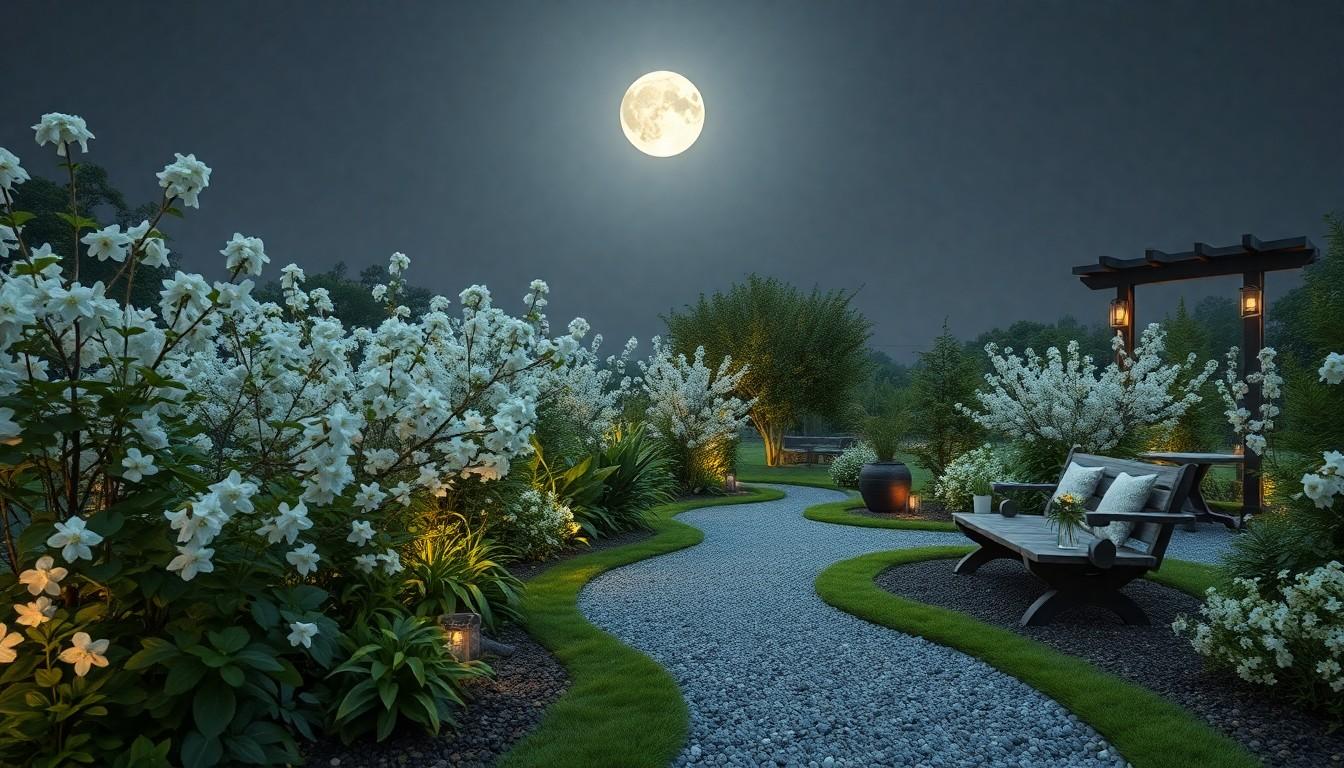Imagine stepping into a garden that glows under the soft embrace of moonlight, where fragrant blooms and shimmering foliage create a serene escape from the chaos of daily life. A moon garden isn’t just a collection of plants; it’s a magical experience that transforms nighttime into a visual feast. With the right selection of flowers and strategic planning, anyone can turn their outdoor space into a dreamy haven that even the moon would envy.
From silvery-white petals to fragrant night-blooming plants, moon garden ideas can elevate any yard into a soothing retreat. Whether it’s for late-night gatherings or peaceful solo strolls, these gardens invite tranquility and beauty. Dive into the world of moon gardens and discover how to harness the enchanting power of lunar light to create a nighttime paradise that’s sure to leave guests starry-eyed.
Overview of Moon Gardens
Moon gardens create a unique atmosphere that thrives under nighttime illumination. These enchanting spaces often feature plants with white or light-colored flowers, which reflect moonlight beautifully. Night-blooming plants attract nocturnal pollinators, enhancing the garden’s biodiversity.
Many gardeners choose fragrant varieties, such as jasmine, evening primrose, or night-blooming cereus, to engage the senses. Planting these species together fosters an inviting and relaxing ambiance. Utilizing reflective surfaces, like water features or garden ornaments, amplifies the garden’s charm.
Designing a moon garden involves planning for both aesthetics and functionality. It’s beneficial to incorporate seating areas for tranquility or social gatherings. Pathways lined with luminescent plants or solar lights create inviting trails through the garden.
Choosing the right location is essential for optimal moon visibility. Selecting an area free from obstructions like tall trees or buildings enhances the lunar effect. Consideration of the garden’s layout contributes to a cohesive design and promotes seamless flow.
Incorporating elements that change with the seasons enriches the garden’s appeal throughout the year. It’s advantageous to include evergreens for winter structure and seasonal blooms for year-round interest.
Reflecting on this serene environment, moon gardens serve as more than just beautiful landscapes; they become personal retreats for relaxation and contemplation.
Benefits of Moon Gardens

Moon gardens offer unique advantages that enhance outdoor spaces. They create an enchanting atmosphere that captivates during nighttime.
Enhanced Nighttime Aesthetics
Moon gardens feature blooms that reflect the gentle glow of moonlight. White or light-colored flowers such as moonflower or Casablanca lily elevate the visual experience. They add shimmer, creating an alluring backdrop for evening gatherings. Additionally, incorporating reflective materials, like gravel paths or light-colored stones, boosts the garden’s luminosity. Illuminating solar lights or lanterns can further enhance visual appeal while ensuring safety. The combination of plants and lighting fosters a magical ambiance, inviting exploration during moonlit nights.
Inviting Evening Relaxation
Evening relaxation becomes effortless in a moon garden. The tranquility of night-blooming plants, such as evening primrose and night jasmine, creates a soothing environment. These fragrant varieties engage the senses and promote peace. Comfortable seating areas surrounded by lush greenery encourage meditation and contemplation. Gentle sounds of nature complete the serene atmosphere, allowing for unwinding after a busy day. Soft lighting from strategically placed fixtures adds to the calming effect, offering an inviting retreat for both solitude and social gatherings.
Choosing the Right Location
Selecting the perfect location for a moon garden plays a crucial role in enhancing its beauty and functionality. The site should ideally capture lunar light while providing tranquility.
Sunlight and Shade Considerations
Light levels greatly influence plant selection. Direct sunlight is necessary for day-blooming varieties, while many moon garden plants thrive in partial shade. Notably, fragrant night-blooming plants like jasmine appreciate dappled light. Choosing a spot that exposes the garden to full moonlight can enhance the visual spectacle. A blend of sun and shade encourages diverse growth, allowing for a harmonious mix of plants. Consider nearby trees or structures that might cast unwanted shadows, as this could hinder the garden’s overall brightness.
Accessibility and Visibility
Ensure pathways lead smoothly through the garden. Easy access increases enjoyment, allowing for intimate exploration during moonlit nights. Incorporating seating areas in visible parts of the garden invites relaxation and social gatherings. Heights matter; raised beds provide visibility and make tending easier. Also, select a location that’s easily seen from windows or patios, enhancing the overall moonlit experience. Plant positioning should facilitate good airflow while keeping the garden visually appealing both day and night.
Plant Selection for Moon Gardens
Selecting the right plants is crucial for creating a captivating moon garden. Focusing on color and scent enhances the nighttime experience.
White and Light-Colored Plants
White and light-colored plants play a significant role in moon gardens. These flowers reflect moonlight, adding an ethereal glow to the garden. Popular options include moonflower, gardenia, and white roses. Consider planting evening primrose for its soft yellow hue, which still illuminates under the moonlight. Achillea ‘Moonshine’ provides a striking contrast with its bright, pale blooms. Incorporating these plants along pathways or in clusters maximizes their visual impact. Light-colored foliage, such as lamb’s ear, enhances the overall aesthetic, creating a serene environment for evening enjoyment.
Fragrant Night-Blooming Flowers
Fragrant night-blooming flowers enrich the sensory experience of moon gardens. These plants release their delightful aromas after sunset, captivating visitors. Jasmine, known for its sweet scent, attracts nocturnal pollinators while enhancing the garden’s allure. Evening stock, with its rich fragrance, also contributes to the enchanting atmosphere. Consider adding datura for its stunning white blossoms and intoxicating scent. Placing these flowers near seating areas invites relaxation and enjoyment during moonlit evenings. Opting for a blend of textures and heights encourages visual interest while ensuring a thriving nighttime garden.
Designing Your Moon Garden
Designing a moon garden involves careful planning and creativity. The goal is to create a space that thrives in the soft glow of moonlight.
Layout and Plant Arrangement
Consider the layout to maximize visual appeal and accessibility. Shapes like circles or curved paths create an inviting atmosphere. Arrange light-colored flowers, such as moonflower and white roses, in clusters to enhance their visual impact. Alternating heights in plantings adds depth and interest while ensuring all plants receive sufficient light. For added contrast, mix in textured foliage that complements blooms. A strategic arrangement facilitates airflow and viewing angles, promoting a harmonious environment where each plant can shine under moonlight.
Incorporating Water Features and Lighting
Incorporating water features elevates the sensory experience of a moon garden. Water elements, like small fountains or ponds, reflect moonlight, enhancing the magical ambiance. Placing these features where they can be easily seen creates focal points that draw attention. Soft lighting options complement nocturnal blooms while promoting safety. Solar-powered lights along pathways or spotlights on key plants highlight key areas without overwhelming the serene atmosphere. Gathering around these illuminated features allows for peaceful relaxation, encouraging nighttime enjoyment and gatherings.
Maintenance Tips for Moon Gardens
Maintaining a moon garden ensures its beauty and tranquility. Seasonal care requires attention to different plants and conditions.
Seasonal Care Practices
In spring, start by pruning any dead growth from perennials. Fertilizing the soil with organic compost enriches nutrients during the growing season. Summer maintenance includes regular watering to keep soil moist, especially for newly planted species. Autumn involves cutting back dead foliage and preparing the garden for winter. Adding mulch helps protect roots from freezing temperatures. Winter months benefit from inspecting plants for damage and clearing pathways of debris.
Pest and Disease Management
Identifying pests early prevents significant damage. Regularly inspect leaves for signs of aphids or other insects. Introducing beneficial insects like ladybugs naturally controls pest populations. For fungal diseases, ensure adequate spacing between plants to improve air circulation. Applying organic fungicides may help manage issues promptly. Monitoring moisture levels also prevents diseases caused by excess water. Keeping the garden clean limits the potential for infestations and promotes healthy growth.
Conclusion
Creating a moon garden offers a unique opportunity to transform outdoor spaces into serene retreats. With careful planning and thoughtful plant selection, anyone can cultivate an enchanting atmosphere that thrives under the glow of the moon. The right combination of light-colored blooms and fragrant night-blooming plants elevates the experience, inviting relaxation and contemplation.
Incorporating elements like winding paths and soft lighting enhances both beauty and functionality. By embracing seasonal changes and maintaining the garden with care, it can remain a captivating haven throughout the year. A moon garden isn’t just a collection of plants; it’s a personal sanctuary that nourishes the soul and encourages connection with nature.

